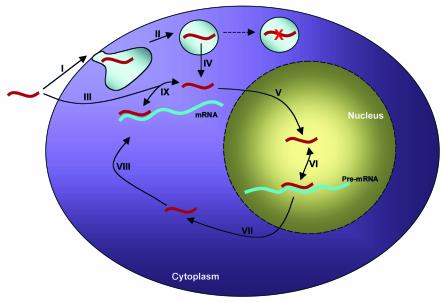Figure 2.
Site of action of antisense oligonucleotide. (I) From the extracellular space, an oligonucleotide or oligonucleotide/cationic lipid complex interacts with the cell surface, presumably through receptor-ligand binding. (II) The oligonucleotide then undergoes endocytosis and is thus sequestered from the rest of the cytoplasm. Alternatively (III) an oligonucleotide conjugated to cell-penetrating peptide fragments may enter the cell via a nonendocytotic mechanism. (IV) Escape from the endosome is facilitated by the cationic lipid. Oligonucleotides that do not escape are degraded in the lysosome (dashed arrow). (V) Once free in the cytoplasm, the oligonucleotide can passively diffuse into the nucleus, where (VI) hybridization to the pre-mRNA target can take place. (VII) Export from the nucleus is energy dependent and involves interactions of the oligonucleotide with nuclear export factors, such as the nuclear pore complex. (VIII) The biologically active oligonucleotide can then bind cytoplasmic mRNA. (IX) The oligonucleotide can also dissociate from the mRNA target and recycle.

